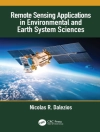Global Vegetation Dynamics: Concepts and Applications in MC1 model describes the creation in the mid 1990s, architecture, uses, and limitations of the MC1 dynamic global vegetation model (DGVM) that is being used by an increasing number of research groups around the world. The scientific foundation of most models is often poorly documented and difficult to access, and a centralized source of information for MC1, including the complete list of over eighty papers and reports with MC1 results will be useful to scientists and users who want to better understand the model and the output it generates.
Global Vegetation Dynamics: Concepts and Applications in MC1 model will be a valuable resource for students and researchers in the fields of climate change science, conservation science, biogeochemistry and ecology, as well as for land managers looking for a better understanding of the projections of climate change impacts and of the tools that have been developed to produce them.
Mục lục
Contributors vii
Preface ix
Acknowledgments xi
Part I: General Description of the Model MC1
1 History and General Description of the Dynamic Global Vegetation Model MC1
Dominique Bachelet 3
2 Historical Climate and Suppression Effects on Simulated Fire and Carbon Dynamics in the Conterminous United States
James M Lenihan and Dominique Bachelet 17
3 Challenges and Limitations of Using a DGVM for Local to Regional Applications
Dominique Bachelet, Brendan M Rogers, and David R Conklin 31
4 The Making of a Dynamic General Vegetation Model, MC1
Ronald P Neilson 41
Part II: Examples of Projects Using MC1 at Various Spatial Scales
5 A Brief Description of the VINCERA Project; Vulnerability and Impacts of North American Forests to Climate Change: Ecosystem Responses and Adaptation
David T Price, Daniel Scott, Mark R Lomas, Daniel W Mc Kenney, Dominique Bachelet, Raymond J Drapek, James M Lenihan, Ronald P Neilson, F I Woodward, and Jonathan A Foley 61
6 Continent?]wide Simulations of a Dynamic Global Vegetation Model over the United States and Canada under Nine AR4 Future Scenarios
Raymond J Drapek, John B Kim, and Ronald P Neilson 73
7 Drivers of Future Ecosystem Change in the US Pacific Northwest: The Role of Climate, Fire, and Nitrogen
Brendan M Rogers, Dominique Bachelet, Raymond J Drapek, Beverly E Law, Ronald P Neilson, and John R Wells 91
8 Application of MC1 to Wind Cave National Park: Lessons from a Small?]Scale Study
David A King, Dominique Bachelet, and Amy J Symstad 115
9 Simulating Effects of Climate and Vegetation Change on Distributions of Martens and Fishers in the Sierra Nevada, California, Using Maxent and MC1
Wayne D Spencer, Heather Rustigian?]Romsos, Ken Ferschweiler, and Dominique Bachelet 135
Part III: Packaging MC1 Results to Increase Its Usability by Managers
10 Using a Dynamic Global Vegetation Model to Help Inform Management Decisions
Joshua S Halofsky, Jessica E Halofsky, David R Conklin, Dominique Bachelet, Miles A Hemstrom, Becky K Kerns, and Anita T Morzillo 153
11 Bringing MC1 Model Results to Data Basin to Facilitate Access, Distribution, and Interpretation
Dominique Bachelet and the CBI Data Basin team 171
Appendix: Publications and Reports Featuring MC1 177
Glossary 183
Index 185
Giới thiệu về tác giả
Dominique Bachelet is a Senior Scientist at the Conservation Biology Institute in Corvallis and Data Basin Climate Center in Oregon. She is the Associate Professor in the Department of Biological and Ecological Engineering at Oregon State University. She was the former director of the Climate Change Science Team for the Nature Conservancy. She completed her Ph.D. in 1983 from Colorado State University working on biogeochemical cycles in the shortgrass prairie. She has authored several research articles including the
Journal of Geophysical Research and a few book chapters. She is a member of the American Geophysical Union, Ecological Society of America and the American Association for the Advancement of Science. Her research expertise is on plant ecology, biogeochemistry and biogeography with special focus on climate change impacts.












